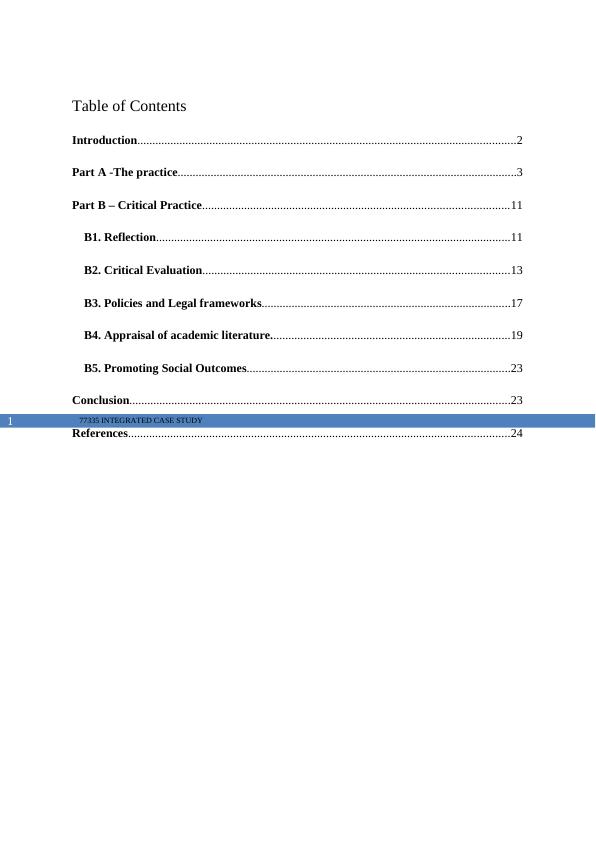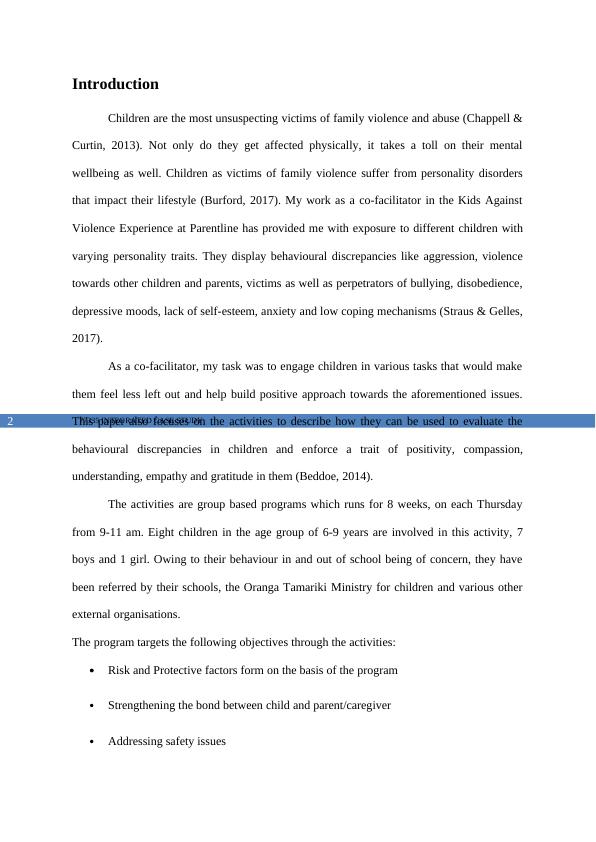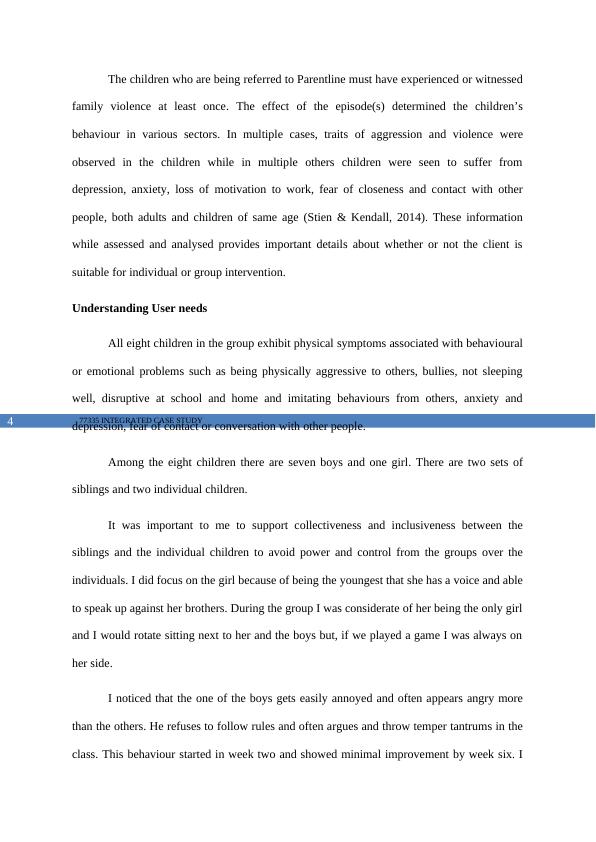77335 Integrated Case Study
Added on 2022-11-25
28 Pages7643 Words277 Views
Running head: 77335 INTEGRATED CASE STUDY
77335 Integrated Case Study
Name of the Student:
Name of the University:
Author Note:
77335 Integrated Case Study
Name of the Student:
Name of the University:
Author Note:

77335 INTEGRATED CASE STUDY1
Table of Contents
Introduction..............................................................................................................................2
Part A -The practice.................................................................................................................3
Part B – Critical Practice......................................................................................................11
B1. Reflection......................................................................................................................11
B2. Critical Evaluation......................................................................................................13
B3. Policies and Legal frameworks...................................................................................17
B4. Appraisal of academic literature................................................................................19
B5. Promoting Social Outcomes........................................................................................23
Conclusion...............................................................................................................................23
References...............................................................................................................................24
Table of Contents
Introduction..............................................................................................................................2
Part A -The practice.................................................................................................................3
Part B – Critical Practice......................................................................................................11
B1. Reflection......................................................................................................................11
B2. Critical Evaluation......................................................................................................13
B3. Policies and Legal frameworks...................................................................................17
B4. Appraisal of academic literature................................................................................19
B5. Promoting Social Outcomes........................................................................................23
Conclusion...............................................................................................................................23
References...............................................................................................................................24

77335 INTEGRATED CASE STUDY2
Introduction
Children are the most unsuspecting victims of family violence and abuse (Chappell &
Curtin, 2013). Not only do they get affected physically, it takes a toll on their mental
wellbeing as well. Children as victims of family violence suffer from personality disorders
that impact their lifestyle (Burford, 2017). My work as a co-facilitator in the Kids Against
Violence Experience at Parentline has provided me with exposure to different children with
varying personality traits. They display behavioural discrepancies like aggression, violence
towards other children and parents, victims as well as perpetrators of bullying, disobedience,
depressive moods, lack of self-esteem, anxiety and low coping mechanisms (Straus & Gelles,
2017).
As a co-facilitator, my task was to engage children in various tasks that would make
them feel less left out and help build positive approach towards the aforementioned issues.
This paper also focuses on the activities to describe how they can be used to evaluate the
behavioural discrepancies in children and enforce a trait of positivity, compassion,
understanding, empathy and gratitude in them (Beddoe, 2014).
The activities are group based programs which runs for 8 weeks, on each Thursday
from 9-11 am. Eight children in the age group of 6-9 years are involved in this activity, 7
boys and 1 girl. Owing to their behaviour in and out of school being of concern, they have
been referred by their schools, the Oranga Tamariki Ministry for children and various other
external organisations.
The program targets the following objectives through the activities:
Risk and Protective factors form on the basis of the program
Strengthening the bond between child and parent/caregiver
Addressing safety issues
Introduction
Children are the most unsuspecting victims of family violence and abuse (Chappell &
Curtin, 2013). Not only do they get affected physically, it takes a toll on their mental
wellbeing as well. Children as victims of family violence suffer from personality disorders
that impact their lifestyle (Burford, 2017). My work as a co-facilitator in the Kids Against
Violence Experience at Parentline has provided me with exposure to different children with
varying personality traits. They display behavioural discrepancies like aggression, violence
towards other children and parents, victims as well as perpetrators of bullying, disobedience,
depressive moods, lack of self-esteem, anxiety and low coping mechanisms (Straus & Gelles,
2017).
As a co-facilitator, my task was to engage children in various tasks that would make
them feel less left out and help build positive approach towards the aforementioned issues.
This paper also focuses on the activities to describe how they can be used to evaluate the
behavioural discrepancies in children and enforce a trait of positivity, compassion,
understanding, empathy and gratitude in them (Beddoe, 2014).
The activities are group based programs which runs for 8 weeks, on each Thursday
from 9-11 am. Eight children in the age group of 6-9 years are involved in this activity, 7
boys and 1 girl. Owing to their behaviour in and out of school being of concern, they have
been referred by their schools, the Oranga Tamariki Ministry for children and various other
external organisations.
The program targets the following objectives through the activities:
Risk and Protective factors form on the basis of the program
Strengthening the bond between child and parent/caregiver
Addressing safety issues

77335 INTEGRATED CASE STUDY3
Group based program
“Breaking the family secret” of domestic violence
Helping children understand protection orders
Developing safety plans
Building support networks
Addressing and discussing separation, loss, grief and family changes
Since the consent of the parents had already been received initially, it was agreed upon
that further consent was not required. A release of information sheet was signed.
Part A -The practice
Prior to the beginning of the programme, I would meet with the facilitator and discuss
the day’s agenda. Thus we know what is to be expected and we can avoid complications due
to confusion or misunderstanding. That is crucial given that we are dealing with a sensitive
issue like family violence.
Assessment
The first stage of the practice is an assessment stage which is done to determine the
suitability of children in the intake process. This process involves that the client meets the
requirement of the program that relates to family violence and abuse. The entire assessment
process ensures that a better understanding and insight is gained in terms of background,
family and friends’ dynamics and environment of the child. Three aspects were categorised in
terms of peer relationship in school and home.
Group based program
“Breaking the family secret” of domestic violence
Helping children understand protection orders
Developing safety plans
Building support networks
Addressing and discussing separation, loss, grief and family changes
Since the consent of the parents had already been received initially, it was agreed upon
that further consent was not required. A release of information sheet was signed.
Part A -The practice
Prior to the beginning of the programme, I would meet with the facilitator and discuss
the day’s agenda. Thus we know what is to be expected and we can avoid complications due
to confusion or misunderstanding. That is crucial given that we are dealing with a sensitive
issue like family violence.
Assessment
The first stage of the practice is an assessment stage which is done to determine the
suitability of children in the intake process. This process involves that the client meets the
requirement of the program that relates to family violence and abuse. The entire assessment
process ensures that a better understanding and insight is gained in terms of background,
family and friends’ dynamics and environment of the child. Three aspects were categorised in
terms of peer relationship in school and home.

77335 INTEGRATED CASE STUDY4
The children who are being referred to Parentline must have experienced or witnessed
family violence at least once. The effect of the episode(s) determined the children’s
behaviour in various sectors. In multiple cases, traits of aggression and violence were
observed in the children while in multiple others children were seen to suffer from
depression, anxiety, loss of motivation to work, fear of closeness and contact with other
people, both adults and children of same age (Stien & Kendall, 2014). These information
while assessed and analysed provides important details about whether or not the client is
suitable for individual or group intervention.
Understanding User needs
All eight children in the group exhibit physical symptoms associated with behavioural
or emotional problems such as being physically aggressive to others, bullies, not sleeping
well, disruptive at school and home and imitating behaviours from others, anxiety and
depression, fear of contact or conversation with other people.
Among the eight children there are seven boys and one girl. There are two sets of
siblings and two individual children.
It was important to me to support collectiveness and inclusiveness between the
siblings and the individual children to avoid power and control from the groups over the
individuals. I did focus on the girl because of being the youngest that she has a voice and able
to speak up against her brothers. During the group I was considerate of her being the only girl
and I would rotate sitting next to her and the boys but, if we played a game I was always on
her side.
I noticed that the one of the boys gets easily annoyed and often appears angry more
than the others. He refuses to follow rules and often argues and throw temper tantrums in the
class. This behaviour started in week two and showed minimal improvement by week six. I
The children who are being referred to Parentline must have experienced or witnessed
family violence at least once. The effect of the episode(s) determined the children’s
behaviour in various sectors. In multiple cases, traits of aggression and violence were
observed in the children while in multiple others children were seen to suffer from
depression, anxiety, loss of motivation to work, fear of closeness and contact with other
people, both adults and children of same age (Stien & Kendall, 2014). These information
while assessed and analysed provides important details about whether or not the client is
suitable for individual or group intervention.
Understanding User needs
All eight children in the group exhibit physical symptoms associated with behavioural
or emotional problems such as being physically aggressive to others, bullies, not sleeping
well, disruptive at school and home and imitating behaviours from others, anxiety and
depression, fear of contact or conversation with other people.
Among the eight children there are seven boys and one girl. There are two sets of
siblings and two individual children.
It was important to me to support collectiveness and inclusiveness between the
siblings and the individual children to avoid power and control from the groups over the
individuals. I did focus on the girl because of being the youngest that she has a voice and able
to speak up against her brothers. During the group I was considerate of her being the only girl
and I would rotate sitting next to her and the boys but, if we played a game I was always on
her side.
I noticed that the one of the boys gets easily annoyed and often appears angry more
than the others. He refuses to follow rules and often argues and throw temper tantrums in the
class. This behaviour started in week two and showed minimal improvement by week six. I

77335 INTEGRATED CASE STUDY5
demonstrated assertiveness because I was able to understand that he is unable to initiate
friendly connections or ask what he need. I understood his basic needs and knew that all
children needs must be met in order for them to focus on learning. We gave him the choice of
finishing his worksheet or to leave it. I could see that his emotions are having an impact on
his concentration and I gave him the choice to complete the worksheet once he felt better. I
was concerned for the child because his other siblings who are in the same group has shown
improvement in their behaviour except him.
My main facilitator had a discussion with the child’s grandfather who reported that
the child visits his mother every fortnight and once he is back home it is very difficult to get
him back into structure and routine.
Further to this, I have discussed this with my manager who used to be a nurse to get a
different perspective. After the group we debriefed and she told us that the child in question
may have “Fetal Alcohol Syndrome” because she noticed noticeable physical appearance of
the syndrome. Feta Alcohol Syndrome can have an effect on the physical, cognitive,
behavioural and neurological developmental disabilities due to excessive exposure to alcohol
during pregnancy. Knowing this information, I was able to show more empathy and used a
strength-based approach which focused on his strengths instead of deficits.
We played a game called STOP, THINK, GO and the purpose of the game is to help
the child to manage his own behaviour and emotions in high risk situations. The child in
question was able to lead the game appropriately and created order between the children. He
engaged well in the game and was able to identify certain emotions
I have also asked him to help me with Kai (food) preparation which gave him a
responsibility and he did very well.
demonstrated assertiveness because I was able to understand that he is unable to initiate
friendly connections or ask what he need. I understood his basic needs and knew that all
children needs must be met in order for them to focus on learning. We gave him the choice of
finishing his worksheet or to leave it. I could see that his emotions are having an impact on
his concentration and I gave him the choice to complete the worksheet once he felt better. I
was concerned for the child because his other siblings who are in the same group has shown
improvement in their behaviour except him.
My main facilitator had a discussion with the child’s grandfather who reported that
the child visits his mother every fortnight and once he is back home it is very difficult to get
him back into structure and routine.
Further to this, I have discussed this with my manager who used to be a nurse to get a
different perspective. After the group we debriefed and she told us that the child in question
may have “Fetal Alcohol Syndrome” because she noticed noticeable physical appearance of
the syndrome. Feta Alcohol Syndrome can have an effect on the physical, cognitive,
behavioural and neurological developmental disabilities due to excessive exposure to alcohol
during pregnancy. Knowing this information, I was able to show more empathy and used a
strength-based approach which focused on his strengths instead of deficits.
We played a game called STOP, THINK, GO and the purpose of the game is to help
the child to manage his own behaviour and emotions in high risk situations. The child in
question was able to lead the game appropriately and created order between the children. He
engaged well in the game and was able to identify certain emotions
I have also asked him to help me with Kai (food) preparation which gave him a
responsibility and he did very well.

End of preview
Want to access all the pages? Upload your documents or become a member.
Related Documents
Client-Centred Intervention and Sociological Imagination in Addressing Family Violencelg...
|4
|908
|388
THE STATUTORY CHILD PROTECTIONlg...
|13
|3061
|18
Mock Ethics Application - Research Proposallg...
|33
|7873
|463
Children and Families: Well-being and Protectionlg...
|21
|5005
|77
Bachelor of Community Mental Health, Alcohol and Other Drugslg...
|19
|2256
|94
